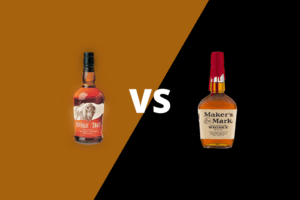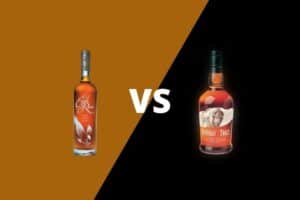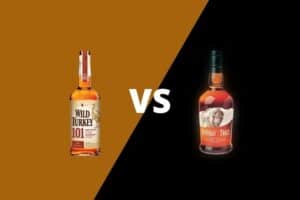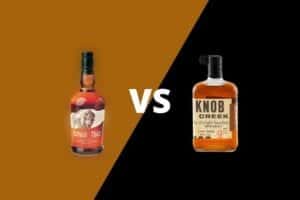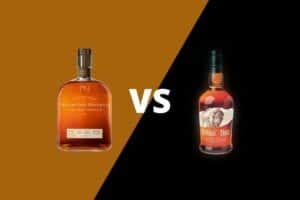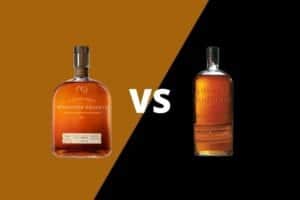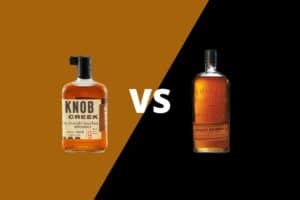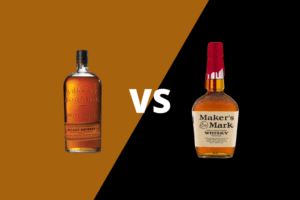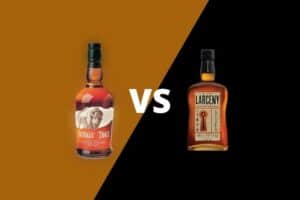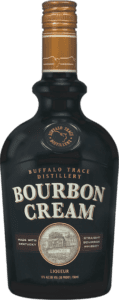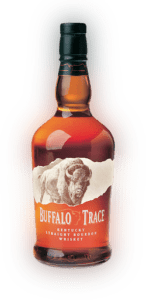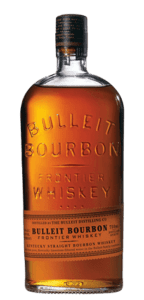Buffalo Trace and Bulleit Bourbon are two of the most well-known American whiskeys on today’s marketplace. Whiskey lovers, bourbon enthusiasts and casual drinkers alike have come across these two iconic brands at one time or another.
But while each of these brands is known for containing delicious, rye-forward liquid in their bottles, they have many subtle differences that give each their own unique character.
In this post, we’ll examine the history, ownership, ingredients, production practices, pricing comparisons and flavor profiles of each of these iconic brands head-to-head to give you some background into what’s going on inside your glass.
Table of Contents
Round 1: History
The Buffalo Trace Distillery has a long history that goes back to 1775 in the pioneer town of Leestown, in what was then the Kentucky territory of Virginia. Over the centuries, the site has been known by many names and for decades operated as the George T. Stagg Distillery. The name was changed to Buffalo Trace when Sazerac purchased the site in 1999. Buffalo Trace Bourbon was first released one year later.
Bulleit Bourbon is named after founder Thomas Bulleit, who created the brand in honor of his great-great-grandfather Augustus Bulleit, a distiller in the 1830s. The Bulleit brand was first introduced to the market in 1987.
After a razor-tight opening round, the judges are divided. While Bulleit Bourbon has been on the market for a bit longer, the Buffalo Trace brand has a historical claim of its own.
Round 2: Ownership
Today, Buffalo Trace Bourbon is owned by spirits producer Sazerac and distilled at the Buffalo Trace Distillery in Frankfurt, Kentucky. Sazerac created the brand in 1999, after acquiring what was then called the George T. Stagg distillery. Sazerac is headquartered in Louisville.
Bulleit Bourbon is owned by Diageo — the world’s largest international alcoholic beverage producer. Based in London, England, Diageo purchased the Bulleit brand in 2000 during the Seagrams spirits division’s dissolution. Today, Bulleit is at the forefront of Diageo’s push into American whiskey.
Round 2 is a draw. Diageo is the undisputed champion in spirits production. But while Diageo focuses primarily on Scotch Whisky and other drinks, Sazerac is the more seasoned American whiskey maker.
Round 3: Mashbills
Buffalo Trace and Bulleit are both Bourbon whiskeys, which means they must include at least 51 percent corn in their mash ingredients. However, it is up to each distiller what grains they want to use for the mashbill’s remainder.
Neither Buffalo Trace or Bulleit publicly disclose the mashbills for their bourbons. But based on their spicy flavor profile, each has a considerable portion of rye in the recipe — a fact neither shies away from in marketing materials. They each contain a percentage of malted barley as well and may contain proportions of wheat.
Another wash in Round 3.
Round 4: Maturation
Let’s look at the label, shall we?
Both Buffalo Trace and Bulleit are labeled as ‘Kentucky Straight Bourbon Whiskey.’ To carry these words on the label, the producers must adhere to production practices that adhere to internationally recognized standards defined by the United States Alcohol Tobacco & Trade Bureau.
Let’s break the label down piece by piece.
Kentucky. Both products are distilled and matured for at least one year in the Commonwealth of Kentucky.
Straight. To be called a ‘Straight’ whiskey, the spirit must be produced using a mash of fermented grains. The distillate cannot exceed 160-proof off the still and must be diluted to less than 125-proof before being placed into the barrel before being matured for a minimum of two years.
Bourbon. To have the word ‘Bourbon’ on the label, the product must contain a distillate of grains fermented using a recipe of at least 51 percent corn. The distillate must be matured in new American charred oak barrels.
Whiskey. This term describes a distillate of fermented grains. There are many types of whiskeys — and while all bourbons are whiskey, not all whiskeys are bourbon.
Okay. So what did we learn?
In terms of maturation, both of these products contain bourbon aged for at least two years. But since neither has an age statement, we do not know precisely how long these whiskeys were matured.
Round 4. Straight. Draw.
Round 5: Distillation & Production
Both of these products were created using modern, high-volume column distillation techniques.
Buffalo Trace is distilled at the historic Buffalo Trace Distillery in Franklin County, Kentucky. Like many Kentucky distilleries, Buffalo Trace Bourbon uses limestone-filtered water in the production of its whiskeys.
Today, Bulleit Bourbon is distilled at the Bulleit Distillery in Shelbyville, Kentucky. But it wasn’t always that way. For a long time, the source of the spirit inside Bulleit bottles was a point of contention among the bourbon aficionado crowd. Diageo opened the Bulleit Distillery in 2017. Before then, it was rumored that the barrels Bulleit used for its brand were distilled at the Midwest Grain Products facility in Lawrenceburg, Indiana.
Another closely-fought matchup. Both products are made at modern distillery complexes using industry-scale techniques. But that’s okay. The big guys are really good at making great whiskey.
Round 6: Price Point & Value
Let’s look at the manufacturer’s suggested retail price to determine which product is the better buy.
Bulleit Bourbon will set you back about $31 for a 750mL bottle. It is bottled at 90-proof, or 45 percent alcohol by volume.
Also bottled at 90-proof, or 45 percent ABV, Buffalo Trace Bourbon goes for a recommended price of about $27.
After another close round, the judges score in favor of Buffalo Trace, which is the better value between the two iconic brands.
Round 7: Tasting Notes
Buffalo Trace Bourbon
Nose: Complex aroma, with notes of oaky wood barrel flavors, leather, tobacco and vanilla.
Palate: Wide range of flavors. Bold, spicy rye character with black pepper and walnut notes.
Finish: Spicy, earthy with lingering toffee and notes of cinnamon.
[Related: Complete Buffalo Trace Bourbon Review]
Bulleit Bourbon
Nose: Bold aroma of charred oak, with spicy rye notes, vanilla, honey and caramel.
Palate: Buttery mouthfeel, with vanilla, butterscotch and a hint of maple syrup.
Finish: Vanilla and baking spices, with lingering almond notes.
[Related: Complete Bulleit Bourbon Review]
Round 7 is too close to call. Both of these bottlings are delicious, and any whiskey geek who wants to experience a high-rye bourbon flavor profile should get these two bourbons into their rotation.
Verdict…
If you’re into high-rye, give these brands a try.
For two brands with very similar mash bills, distilling techniques and maturation processes, Buffalo Trace is definitely the better value. But Bulleit is a brand with a very enthusiastic following, and that many bourbon drinkers can’t be wrong.
If you’re into the spicy flavor of high-rye bourbon whiskey, you could do worse than to place these two excellent whiskeys in a side-by-side tasting. Then, you can judge the winner for yourself!














